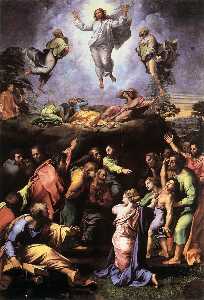Artista: Raphael (Raffaello Sanzio Da Urbino)
Estilo: Renaissance
tópicos: Women
Técnica: Oil
Lady with a Unicorn is a painting, oil on canvas applied to wood, by Raphael, c. 1506. It is in the Galleria Borghese in Rome. The portrait appears to have been influenced by the Mona Lisa, painted by Leonardo between 1503 and 1506. The work was of uncertain attribution until recent times. In the 1760 inventory of the Gallery, the subject of the painting was identified as Saint Catherine of Alexandria and attributed to Perugino. A restoration of the painting in 1934-36 confirmed art historian Roberto Longhi's hypothesis that the work was by Raphael, and the removal of heavy repainting revealed the unicorn, traditionally a symbol of purity in medieval romance, in place of a Saint Catherine's wheel. Later restoration work on the painting in 1959 revealed the image of a dog, even earlier than the unicorn, also a symbol of chastity and conjugal fidelity. The identity of the young woman, and the client for whom the work was done, are both unknown.
Artista |
|
|---|---|
baixar |
|
permissões |
Grátis para uso não comercial. Ver abaixo. |
Raphael (Raffaello Sanzio Da Urbino) – Obras de arte mais vistos
|
This image (or other media file) is in the public domain because its copyright has expired. However - you may not use this image for commercial purposes and you may not alter the image or remove the watermark. This applies to the United States, Canada, the European Union and those countries with a copyright term of life of the author plus 70 years.
|














![Stanze Vaticane - The Fire in the Borgo (detail) [01] Stanze Vaticane - The Fire in the Borgo (detail) [01]](https://img.wikioo.org/ADC/art.nsf/get_small_image?Open&ra=5ZKE9P)
 Note that a few countries have copyright terms longer than 70 years: Mexico has 100 years, Colombia has 80 years, and Guatemala and Samoa have 75 years. This image may
not be in the public domain in these countries, which moreover do not implement the
Note that a few countries have copyright terms longer than 70 years: Mexico has 100 years, Colombia has 80 years, and Guatemala and Samoa have 75 years. This image may
not be in the public domain in these countries, which moreover do not implement the